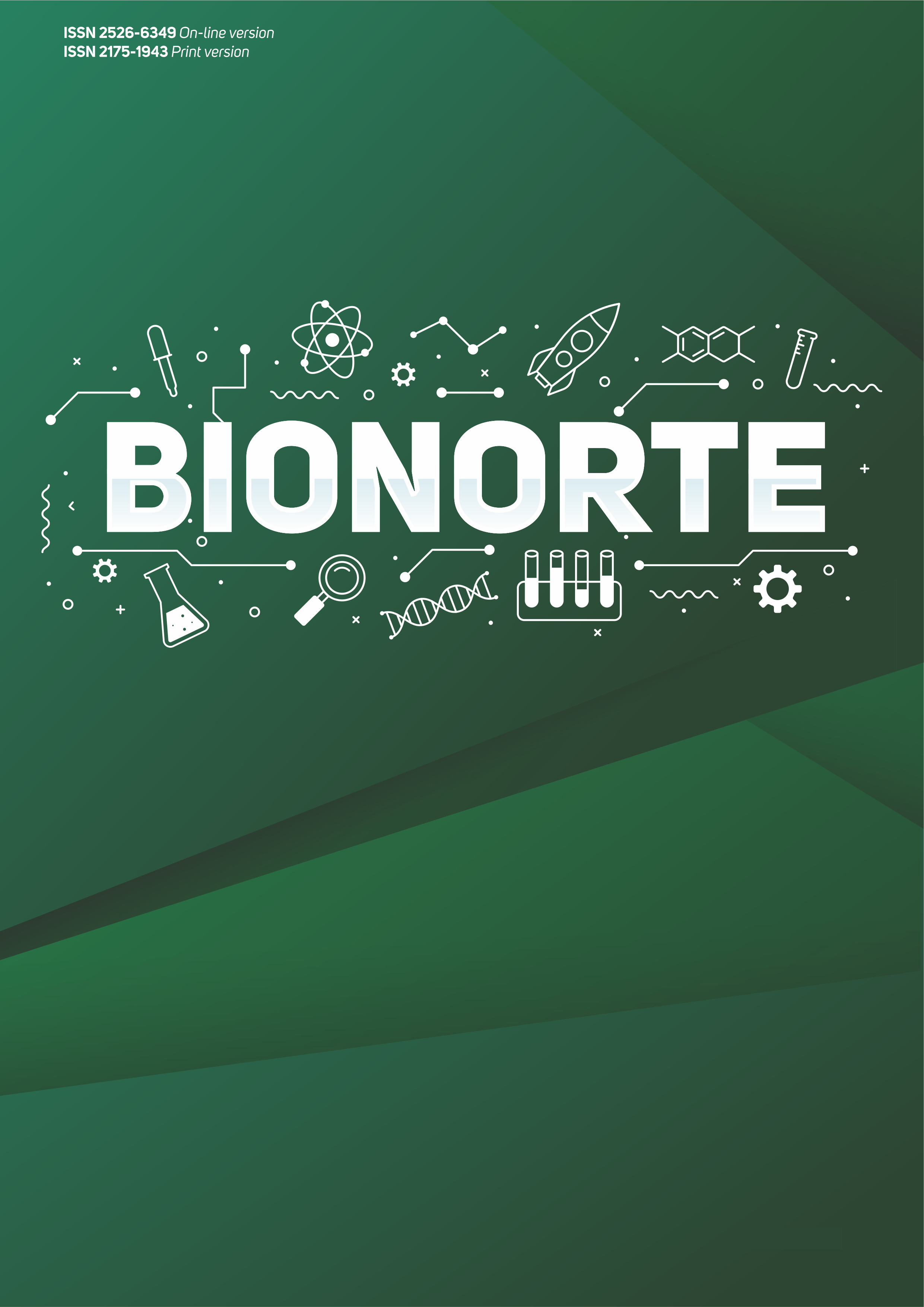Espectro clínico da mutação genética de SYNGAP1
uma revisão integrativa
DOI:
https://doi.org/10.47822/bn.v13iSuppl.3.933Palavras-chave:
Transtornos do neurodesenvolvimento, Deficiência intelectual, EpilepsiaResumo
Objetivo: delinear as variações do espectro fenotípico dos distúrbios por mutações no gene SYNGAP1 para caracterizar as manifestações clínicas e comportamentais existentes. Materiais e Métodos: trata-se de uma Revisão Integrativa da literatura desenvolvida com busca avançada nas bases de dados PubMed, Biblioteca Virtual em Saúde (BVS) e Scientific Electronic Library Online (SciELO), por meio dos descritores: “SYNGAP1” AND “Neurodevelopmental Disorders” AND “Intellectual Disability” AND “Epilepsy” e seus respectivos correspondentes em português. Foram incluídos artigos que atenderam ao tema, sem restrição de tempo, selecionando-os pela análise dos títulos, resumos e leitura na íntegra. Resultados: foram selecionados 17 de 34 artigos, publicados entre 2011 e 2023, com localidade americana, europeia e asiática, mas nenhuma em território brasileiro. A maioria dos artigos analisou crianças e apenas um abordou, em sua amostra, paciente adulto. As principais manifestações observadas foram epilepsia, déficit intelectual, Transtorno do Espectro Autista, alterações locomotoras, anormalidades do sono, respostas cerebrais alteradas, comprometimento auditivo e aspectos físicos com semelhanças compartilhadas. Conclusão: mutações no gene SYNGAP1 geram um abrangente espectro clínico com estudos ainda limitados, apesar disso, verifica-se a prevalência da encefalopatia epiléptica, Transtorno do Espectro Autista e deficiência intelectual na maioria dos casos.
Referências
AGARWAL, M.; JOHNSTON, M. V.; STAFSTROM, C. E. SYNGAP1 mutations: Clinical, genetic, and pathophysiological features. International Journal of Developmental Neuroscience, v. 78, p. 65–76, nov. 2019. https://doi.org/10.1016/j.ijdevneu.2019.08.003
BERRYER, M. H. et al. Mutations inSYNGAP1Cause Intellectual Disability, Autism, and a Specific Form of Epilepsy by Inducing Haploinsufficiency. Human Mutation, v. 34, n. 2, p. 385–394, 12 dez. 2012. https://doi.org/10.1002/humu.22248
BRITO, A. M. G. et al. Uso indiscriminado de antibióticos: uma revisão integrativa. Revista Bionorte, v. 11, n. 1, p. 219-225, 2022. Available from: https://doi.org/10.47822/bn.v11i1.245
CÔTÉ, V. et al. Differential auditory brain response abnormalities in two intellectual disability conditions: SYNGAP1 mutations and Down syndrome. Clinical Neurophysiology, v. 132, n. 8, p. 1802–1812, ago. 2021. https://doi.org/10.1016/j.clinph.2021.03.054
HAMDAN, F. F. et al. De Novo SYNGAP1 Mutations in Nonsyndromic Intellectual Disability and Autism. Biological Psychiatry, v. 69, n. 9, p. 898–901, maio 2011. https://doi.org/10.1016/j.biopsych.2010.11.015
JIMENEZ-GOMEZ, A. et al. Phenotypic characterization of individuals with SYNGAP1 pathogenic variants reveals a potential correlation between posterior dominant rhythm and developmental progression. Journal of Neurodevelopmental Disorders, v. 11, n. 1, 8 ago. 2019. https://doi.org/10.1186/s11689-019-9276-y
KLITTEN, L. L. et al. A balanced translocation disruptsSYNGAP1in a patient with intellectual disability, speech impairment, and epilepsy with myoclonic absences (EMA). Epilepsia, v. 52, n. 12, p. e190–e193, 2 nov. 2011. https://doi.org/10.1111/j.1528-1167.2011.03304.x
MORAIS, A. C. R. Conhecimento de professores sobre primeiros socorros: revisão integrativa da literatura. Revista Bionorte, v. 12, n. Suppl.2, p. 14–21, 2023. Available from: http://doi.org/10.47822/bn.v12iSuppl.2.525
PAASCH, V. et al. An exploratory study of sleep quality and quantity in children with causal variants in SYNGAP1, an autism risk gene. Sleep Medicine, v. 107, p. 101–107, 1 jul. 2023. https://doi.org/10.1016/j.sleep.2023.04.008
PARKER, M. J. et al. De novo, heterozygous, loss-of-function mutations in SYNGAP1 cause a syndromic form of intellectual disability. American Journal of Medical Genetics Part A, v. 167, n. 10, p. 2231–2237, 15 jun. 2015. https://doi.org/10.1002/ajmg.a.37189
PRCHALOVA, D. et al. Analysis of 31-year-old patient with SYNGAP1 gene defect points to importance of variants in broader splice regions and reveals developmental trajectory of SYNGAP1-associated phenotype: case report. BMC Medical Genetics, v. 18, n. 1, 2 jun. 2017. https://doi.org/10.1186/s12881-017-0425-4
SMITH-HICKS, C. et al. Sleep Abnormalities in the Synaptopathies—SYNGAP1-Related Intellectual Disability and Phelan–McDermid Syndrome. Brain Sciences, v. 11, n. 9, p. 1229, 17 set. 2021. https://doi.org/10.3390/brainsci11091229
TANG, S. et al. Phenotypic and genetic spectrum of epilepsy with myoclonic atonic seizures. Epilepsia, v. 61, n. 5, p. 995–1007, maio 2020. https://doi.org/10.1111/epi.16508
VERMA, V. et al. Identification of an individual with a SYGNAP1 pathogenic mutation in India. Molecular Biology Reports, v. 47, n. 11, p. 9225–9234, 1 nov. 2020. https://doi.org/10.1007/s11033-020-05915-4
VLASKAMP, D. R. M. et al. SYNGAP1 encephalopathy: A distinctive generalized developmental and epileptic encephalopathy. Neurology, v. 92, n. 2, p. e96–e107, 12 dez. 2019. https://doi.org/10.1212/wnl.0000000000006729
WANG, X. L. et al. Autosomal dominant mental retardation type 5 caused by SYNGAP1 gene mutations: a report of 8 cases and literature review. Zhongguo Dang Dai Er Ke Za Zhi = Chinese Journal of Contemporary Pediatrics, v. 25, n. 5, p. 489–496, 15 maio 2023. https://doi.org/10.7499/j.issn.1008-8830.2301054
WELDON, M. et al. The first international conference on SYNGAP1-related brain disorders: a stakeholder meeting of families, researchers, clinicians, and regulators. Journal of Neurodevelopmental Disorders, v. 10, n. 1, 5 fev. 2018. https://doi.org/10.1186/s11689-018-9225-1
WRIGHT, D. et al. Clinical and behavioural features of SYNGAP1-related intellectual disability: a parent and caregiver description. Journal of Neurodevelopmental Disorders, v. 14, n. 1, 2 jun. 2022. https://doi.org/10.1186/s11689-022-09437-x
WRITZL, K.; KNEGT, A. C. 6p21.3 microdeletion involving theSYNGAP1gene in a patient with intellectual disability, seizures, and severe speech impairment. American Journal of Medical Genetics Part A, v. 161, n. 7, p. 1682–1685, 17 maio 2013. https://doi.org/10.1002/ajmg.a.35930
ZOLLINO, M. et al. Integrated analysis of clinical signs and literature data for the diagnosis and therapy of a previously undescribed 6p21.3 deletion syndrome. European journal of human genetics: EJHG, v. 19, n. 2, p. 239–242, 1 fev. 2011. https://doi.org/10.1038/ejhg.2010.172
Downloads
Publicado
Como Citar
Edição
Seção
Licença
Copyright (c) 2024 Déborah Pereira Miranda Cardoso, Renata Andrade de Resende

Este trabalho está licenciado sob uma licença Creative Commons Attribution 4.0 International License.







